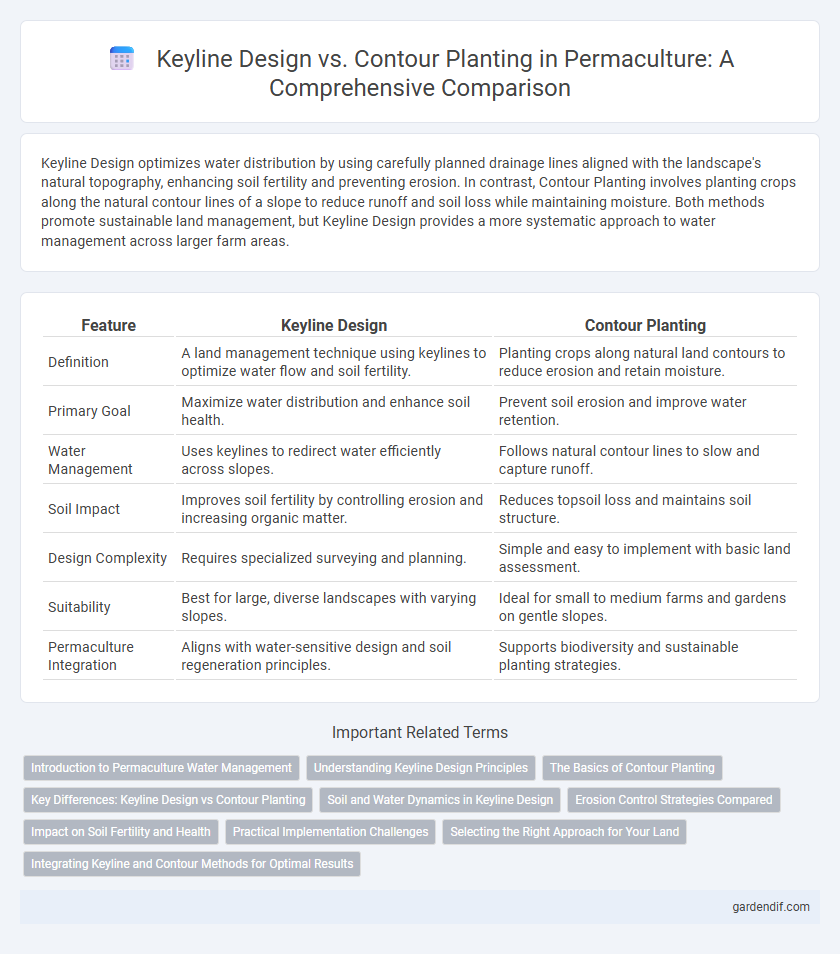
Keyline Design vs Contour Planting Illustration
Keyline Design optimizes water distribution by using carefully planned drainage lines aligned with the landscape's natural topography, enhancing soil fertility and preventing erosion. In contrast, Contour Planting involves planting crops along the natural contour lines of a slope to reduce runoff and soil loss while maintaining moisture. Both methods promote sustainable land management, but Keyline Design provides a more systematic approach to water management across larger farm areas.
Table of Comparison
| Feature | Keyline Design | Contour Planting |
|---|---|---|
| Definition | A land management technique using keylines to optimize water flow and soil fertility. | Planting crops along natural land contours to reduce erosion and retain moisture. |
| Primary Goal | Maximize water distribution and enhance soil health. | Prevent soil erosion and improve water retention. |
| Water Management | Uses keylines to redirect water efficiently across slopes. | Follows natural contour lines to slow and capture runoff. |
| Soil Impact | Improves soil fertility by controlling erosion and increasing organic matter. | Reduces topsoil loss and maintains soil structure. |
| Design Complexity | Requires specialized surveying and planning. | Simple and easy to implement with basic land assessment. |
| Suitability | Best for large, diverse landscapes with varying slopes. | Ideal for small to medium farms and gardens on gentle slopes. |
| Permaculture Integration | Aligns with water-sensitive design and soil regeneration principles. | Supports biodiversity and sustainable planting strategies. |
Introduction to Permaculture Water Management
Keyline Design optimizes water distribution by harnessing natural topography to maximize soil moisture, improving irrigation efficiency in permaculture systems. Contour Planting follows land elevation contours to reduce runoff and prevent soil erosion, enhancing water retention around root zones. Both methods integrate sustainable water management practices essential for maintaining long-term ecosystem health in permaculture landscapes.
Understanding Keyline Design Principles
Keyline Design optimizes water distribution across landscapes by precisely identifying and utilizing keypoints and keylines to control runoff and enhance soil fertility. Unlike contour planting, which follows natural elevation lines, Keyline Design leverages engineered earthworks to maximize water infiltration and promote sustainable land use. Understanding Keyline principles involves recognizing landform patterns, slope gradients, and strategic placement of channels to increase productive potential in permaculture systems.
The Basics of Contour Planting
Contour planting involves arranging crops along the natural contours of the land to reduce soil erosion and improve water retention. This method helps slow down water runoff, allowing more time for infiltration into the soil, which benefits plant growth and soil health. Unlike keyline design, which integrates precise earthworks and water flow control, contour planting primarily focuses on maintaining soil structure through crop alignment.
Key Differences: Keyline Design vs Contour Planting
Keyline Design involves a strategic layout for water management using plow lines drawn parallel to the keyline, which is a contour just off the ridge, aiming to maximize water infiltration and soil fertility across undulating terrain. Contour Planting strictly follows the natural contour lines of the land to reduce soil erosion and water runoff by planting crops along these level lines. The primary difference lies in Keyline Design's intentional modification of contours to optimize water distribution, whereas Contour Planting adheres exactly to existing contour lines without altering the land structure.
Soil and Water Dynamics in Keyline Design
Keyline Design optimizes soil and water dynamics by directing water flow through carefully planned ridges and valleys, maximizing water infiltration and minimizing erosion. Unlike contour planting, which follows natural elevation lines, Keyline Design strategically places cultivation lines to enhance water distribution and improve soil aeration. This method increases soil fertility and moisture retention, promoting sustainable land management in permaculture systems.
Erosion Control Strategies Compared
Keyline Design uses controlled water flow along engineered ridge and valley patterns to maximize soil moisture retention and reduce erosion, whereas Contour Planting follows natural land contours to slow water runoff and stabilize soil. Keyline Design strategically places cultivation lines to direct excess water toward dry areas, enhancing infiltration and minimizing surface erosion. Contour Planting primarily relies on vegetation barriers and terracing to prevent soil displacement, making it effective for steady slopes but less adaptable to varied terrain than Keyline Design.
Impact on Soil Fertility and Health
Keyline design enhances soil fertility by maximizing water distribution across the landscape through strategically placed keylines, promoting deep water infiltration and reducing erosion. Contour planting follows natural land contours to minimize runoff and soil loss, maintaining organic matter and microbial activity. Both methods improve soil health but Keyline design offers more dynamic water management for sustained nutrient cycling and increased soil vitality.
Practical Implementation Challenges
Keyline Design requires precise earthworks and specialized tools to create contour-aligned channels for water distribution, often demanding expert knowledge and significant labor investment. Contour Planting, while simpler to implement, presents challenges in accurately mapping land contours to prevent soil erosion and optimize water retention. Both methods necessitate careful site assessment and ongoing maintenance to effectively enhance soil fertility and water management in permaculture systems.
Selecting the Right Approach for Your Land
Keyline Design optimizes water distribution by aligning cultivation patterns with the natural slope of the land, enhancing soil fertility and moisture retention. Contour Planting follows the land's elevation contours to reduce erosion and improve water absorption on hilly terrains. Selecting the right approach depends on soil type, slope gradient, and local climate, ensuring sustainable land management and maximum productivity in permaculture systems.
Integrating Keyline and Contour Methods for Optimal Results
Integrating Keyline Design and Contour Planting enhances soil moisture retention and erosion control by aligning water management with natural land contours and subsoil structures. Keyline's emphasis on strategic plowing patterns complements Contour Planting's vegetation alignment, promoting improved water infiltration and nutrient distribution across the landscape. Combining these methods maximizes ecosystem productivity and resilience in permaculture systems.
Keyline Design vs Contour Planting Infographic

 gardendif.com
gardendif.com